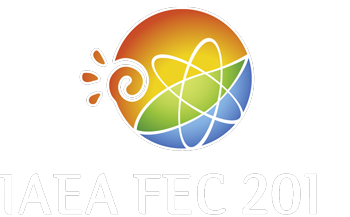Speaker
Dr
Toru Tsujimura
(National Institute for Fusion Science)
Description
The central electron temperature of high-ion-temperature plasmas was successfully increased in the large helical device (LHD) up to 7.6 keV for the central ion temperature of 6 keV and a central electron density of 1.4 x 10^(19) m^(-3) by adding a new 154-GHz gyrotron and also by optimization of the ECRH (electron cyclotron resonance heating) injection. The optimization was carried out using the ray-tracing code "LHDGauss," upgraded to include three new features: 1) rapid post-processing 3D equilibrium mapping, 2) refraction of rays in the peripheral region with the finite density gradient outside of the last closed flux surface, and 3) calculations of the ordinary/extraordinary (O/X) mode ratio. The absolute value of the power deposition profiles calculated at every shot enables feedback of the injection condition for the required deposition profile on a shot-by-shot basis, which resulted in the achievement of the high-temperature plasma. The impact of a plasma peripheral region not only on refraction of rays but also on pure excitation of the O/X mode is a common characteristic in magnetically confined plasmas with comparable scale lengths for the density and the magnetic shear angle, e.g., the stochastic region of LHD plasmas, or tokamak pedestal/SOL (scrape-off-layer) plasmas. The adjustment of the ECRH injection settings using the ray-tracing code integrating the LHD peripheral region in 3D equilibrium mapping has contributed to the successful extension of the LHD operational regime.
| Country or International Organization | Japan |
|---|---|
| Paper Number | EX/P8-2 |
Author
Dr
Toru Tsujimura
(National Institute for Fusion Science)
Co-authors
Dr
Hiroe Igami
(National Institute for Fusion Science)
Dr
Hiromi Takahashi
(National Institute for Fusion Science)
Prof.
Masaki Osakabe
(National Institute for Fusion Science)
Prof.
Masayuki Yokoyama
(National Institute for Fusion Science)
Dr
Ryohei Makino
(National Institute for Fusion Science)
Dr
Ryosuke Seki
(National Institute for Fusion Science)
Prof.
Shin Kubo
(National Institute for Fusion Science)
Prof.
Takashi Mutoh
(National Institute for Fusion Science)
Prof.
Takashi Shimozuma
(National Institute for Fusion Science)
Dr
Yasuo Yoshimura
(National Institute for Fusion Science)

